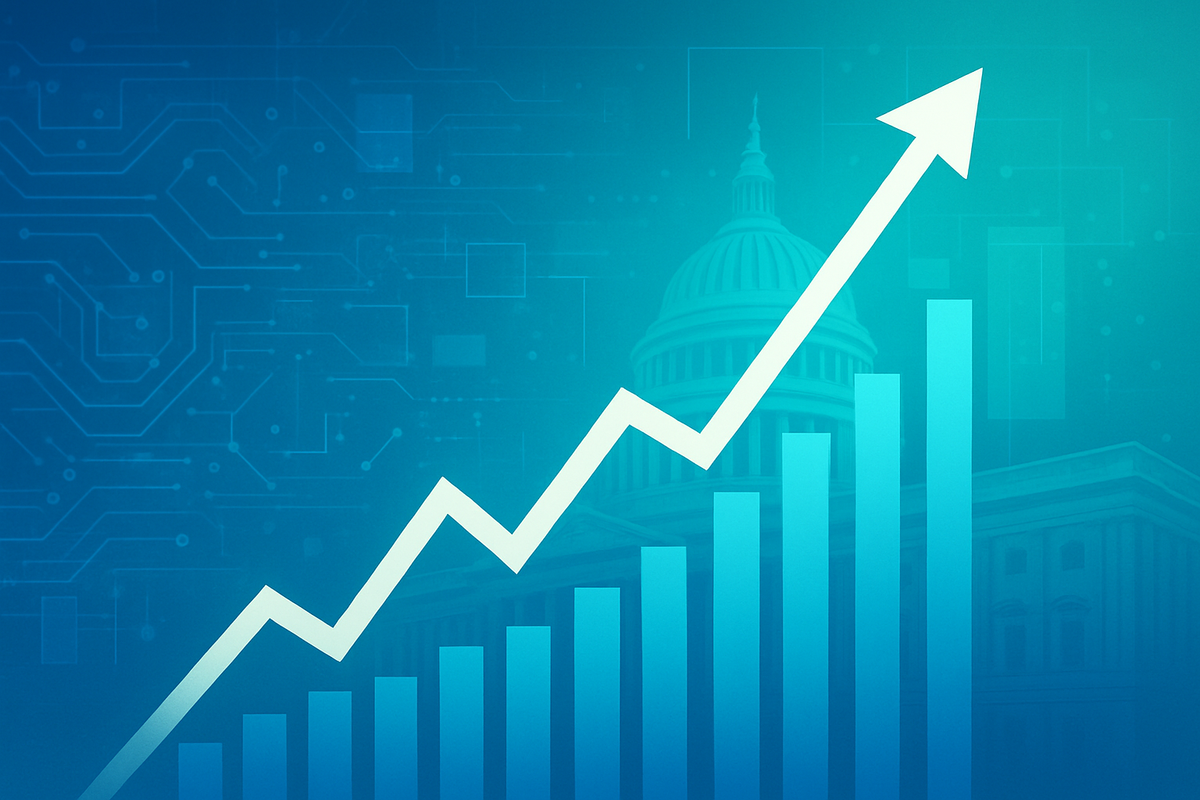
The U.S. stock market experienced a robust rebound on Monday, November 10, 2025, with major indexes surging on widespread optimism that a protracted government shutdown is finally nearing its conclusion. This significant upswing follows a turbulent period, particularly for the tech sector, which had recently faced a slump amidst renewed concerns over valuations and a potential "AI bubble." The immediate implication is a restored sense of stability and a resurgence of risk appetite among investors, eager to re-engage with equities after weeks of economic uncertainty.
This market resurgence is a direct response to a breakthrough in Washington, where the Senate advanced a crucial procedural measure for a bipartisan bill late Sunday, November 9, 2025, aimed at reopening the federal government. The prospect of an end to the record-setting shutdown, which has persisted for between 39 and 41 days, has acted as a powerful catalyst, alleviating a major overhang that had been stifling economic activity and investor confidence. While the relief is palpable, underlying concerns about future fiscal stability and tech valuations persist, suggesting a cautious optimism rather than unbridled euphoria.
Detailed Coverage: Unpacking the Market's Ascent
The market's dramatic turnaround on November 10, 2025, saw all three major U.S. stock indexes clawing back substantial portions of the previous week's losses. The tech-heavy Nasdaq Composite (NASDAQ: COMP) led the charge, soaring approximately 2%, while the benchmark S&P 500 (NYSEARCA: SPY) gained about 1.3%, and the Dow Jones Industrial Average (NYSEARCA: DIA) rose by 0.5%. This impressive rally came after the Nasdaq had recorded its worst weekly performance since April, dropping 3% as investors grappled with fears of overvaluation, particularly within the burgeoning artificial intelligence space. The rebound highlights the market's sensitivity to political stability and its readiness to embrace growth opportunities once perceived risks are mitigated.
The timeline leading up to this moment was fraught with tension and economic headwinds. The government shutdown, which began in early October, had progressively tightened its grip on the U.S. economy. Key economic data releases, including the Consumer Price Index (CPI) and Producer Price Index (PPI), were delayed, creating a vacuum of information crucial for the Federal Reserve's interest rate decisions. Consumer sentiment plummeted to its lowest level since June 2022, reflecting widespread public anxiety. Disruptions to federal operations were far-reaching, impacting everything from air travel, with thousands of flights canceled, to the broader functioning of regulatory bodies, all contributing to fears of a potential economic contraction.
Key players in this unfolding drama included congressional leaders from both parties, the White House, and, by extension, the American public and global financial markets. The prolonged stalemate highlighted deep partisan divisions over fiscal policy and spending. The eventual breakthrough on Sunday, November 9, 2025, signaled a crucial shift towards compromise, with a bipartisan bill gaining traction in the Senate. This move was widely interpreted by investors as a sign that the political gridlock, which had directly contributed to market uncertainty and the recent tech slump, was finally breaking.
Initial market reactions were overwhelmingly positive, characterized by a significant "risk-on" sentiment. Traders moved swiftly to re-enter equity markets, driving up stock prices across various sectors, though tech remained the primary beneficiary. Even cryptocurrencies, such as Bitcoin (CRYPTO: BTC), saw a corresponding rise, underscoring the broad return of investor confidence. Treasury yields ticked higher as demand for safe-haven assets waned, while gold prices recovered above $4,000 an ounce, and crude oil benchmarks also saw gains on renewed optimism for increased demand. This immediate response underscores the market's deep desire for certainty and its inherent capacity for rapid recovery once major uncertainties are addressed.
Companies Poised for Gains and Those Facing Lingering Challenges
The resolution of the government shutdown and the subsequent market rebound are creating a distinct landscape of winners and losers within the public company sphere, with the tech sector once again taking center stage. While the overall sentiment is positive, the impact varies significantly based on a company's reliance on federal operations, its market capitalization, and its position within key growth trends like Artificial Intelligence.
Leading the charge among the likely winners are the large-cap technology giants, often referred to as the "Magnificent Seven." Companies such as Apple (NASDAQ: AAPL), Microsoft (NASDAQ: MSFT), Nvidia (NASDAQ: NVDA), Alphabet (NASDAQ: GOOGL), Amazon (NASDAQ: AMZN), Meta (NASDAQ: META), and Tesla (NASDAQ: TSLA) are poised to benefit immensely. Their diversified revenue streams, global reach, and robust financial positions make them resilient to temporary domestic disruptions. Nvidia, a leader in AI chips, and Microsoft, with its extensive AI integration in Azure, are particularly well-positioned to capitalize on renewed investor confidence in the AI boom. The end of regulatory delays, which can affect new product approvals or mergers, will also clear the path for their future strategic initiatives.
Semiconductor manufacturers are another category set for significant gains. Companies like Nvidia (NASDAQ: NVDA), Broadcom (NASDAQ: AVGO), Micron Technology (NASDAQ: MU), and the crucial foundry Taiwan Semiconductor Manufacturing Co. (NYSE: TSM) are fundamental to the entire tech ecosystem, especially with the accelerating demand for AI infrastructure. During the market rebound, stocks like Micron and Super Micro Computer (NASDAQ: SMCI) saw early gains, reflecting the market's renewed appetite for the foundational components of technological advancement. Their future outlook remains strong, assuming global supply chains maintain stability.
Conversely, while the end of the shutdown is a net positive, some companies, particularly smaller government contractors, may face lingering challenges or a slower recovery. Firms like Leidos (NYSE: LDOS), Booz Allen Hamilton (NYSE: BAH), and Palantir Technologies (NYSE: PLTR), which have substantial federal contracts, will see operations normalize and delayed payments released, improving their cash flow and revenue. However, smaller and mid-sized contractors often lack the financial buffers of their larger counterparts, and the significant cash flow disruptions and potential workforce losses incurred during the 39-41 day shutdown could take time to fully overcome. While they will eventually rebound, the initial strain and administrative backlogs post-shutdown could temper their immediate recovery. Additionally, tech companies heavily reliant on specific regulatory approvals or federal grants, such as those awaiting FCC spectrum allocations or NSF research funding, will experience the resolution of delays but will still have to contend with the backlog created during the shutdown, potentially impacting their agility and time-to-market for new innovations.
Wider Significance: Navigating the AI Era Amidst Political Realities
The stock market's robust rebound, catalyzed by the prospective end of the US government shutdown and spearheaded by the tech sector, carries profound wider significance, illustrating the market's inherent resilience and the dominant influence of Artificial Intelligence in late 2025. This event is not merely a temporary relief from political gridlock but a signal of how broader industry trends, regulatory landscapes, and historical patterns continue to shape the financial future.
At the heart of the current market dynamic is the pervasive influence of Artificial Intelligence and Generative AI (GenAI). These technologies remain the primary drivers of innovation and investment, demanding significant capital allocation towards scalable, energy-efficient data center infrastructure. This "AI-powered everything" trend is reshaping every industry, from cybersecurity, where AI offers both advanced defenses and novel threats, to digital transformation initiatives across the globe. The tech sector's ability to lead this rebound, even after a slump, underscores its foundational role in the modern economy and its capacity to attract investment based on future growth potential, largely tied to AI's continued evolution.
The ripple effects of this tech-led resurgence are far-reaching. The semiconductor industry, the bedrock of AI, sees companies like Nvidia (NASDAQ: NVDA) and their partners, such as Taiwan Semiconductor Manufacturing Co. (NYSE: TSM) and SK Hynix (KRX: 000660), as major beneficiaries. The explosion of AI workloads translates directly into soaring demand for data storage solutions and cloud computing services, benefiting firms like Seagate Technology (NASDAQ: STX), Micron Technology (NASDAQ: MU), and Western Digital (NASDAQ: WDC). This robust performance among dominant tech firms, however, also raises questions about market concentration, potentially reinforcing the trend where a few powerful players dictate the pace of innovation and market growth, reminiscent of post-dot-com bust dynamics.
On the regulatory front, the rebound occurs amidst an increasingly scrutinizing environment for the tech sector. The notion of an "unregulated wild west" is rapidly becoming antiquated. New AI regulations, such as the EU AI Act (with initial implementation steps in February 2025 and rules for General Purpose AI models in August 2025) and state-level legislation like the Colorado AI Act, demand greater transparency and accountability. Simultaneously, new digital markets and antitrust regimes, like the EU's Digital Markets Act (DMA) and the UK's Digital Markets Competition and Consumers Act (DMCCA), which came into force in early 2025, are imposing stricter conduct requirements on firms with "strategic market status." This evolving regulatory landscape means that while innovation continues, tech giants must increasingly navigate a complex web of compliance, potentially influencing their strategic decisions and market entry strategies. Furthermore, the resolution of the government shutdown, especially one of its unprecedented length, will undoubtedly influence future fiscal policy debates, with discussions around long-term budgeting and the Federal Reserve's monetary policy in light of the economic disruptions.
Historically, the market's reaction to government shutdowns has often been characterized by short-term volatility followed by a relatively swift recovery, with the S&P 500 (NYSEARCA: SPY) generally showing resilience. However, this shutdown, described as the longest in U.S. history, may carry a more significant, albeit still temporary, impact on consumer sentiment and potentially lead to some permanent economic loss, even if not plunging the economy into a recession. Comparisons to past tech market cycles, such as the dot-com bubble, are also being drawn, with critics questioning if AI valuations have become "too high and too fast." Yet, unlike the dot-com era's speculative fervor, current tech growth is largely backed by strong profit fundamentals from established companies, suggesting a more robust, albeit potentially concentrated, innovation cycle. The overarching historical precedent remains the market's consistent ability to rebound from periods of political uncertainty and economic shocks, underscoring its preference for stability.
What Comes Next: Navigating Volatility and Unlocking AI's Full Potential
The immediate euphoria surrounding the end of the government shutdown and the subsequent market rebound on November 10, 2025, sets the stage for a period of both opportunity and caution for the stock market and the tech sector. While historical patterns suggest resilience, the unprecedented length of this shutdown and the current economic climate introduce unique dynamics that will shape short-term volatility and long-term strategic decisions.
In the short term, investors should brace for potential volatility as a backlog of crucial economic data, including inflation and employment reports, is finally released. These reports, delayed by the shutdown, could significantly influence market sentiment and the Federal Reserve's stance on interest rates, especially given their recent cautious approach to rate cuts. Consumer sentiment, though likely to recover, may still reflect a degree of lingering caution from the prolonged uncertainty. For the tech sector, while the initial rebound has been strong, the focus will remain intensely on corporate earnings and forecasts. Companies like Nvidia (NASDAQ: NVDA) and Palantir Technologies (NYSE: PLTR), having led the rally, will need to demonstrate continued fundamental strength to sustain momentum.
Looking further ahead, the long-term outlook for the tech sector remains largely optimistic, driven by the transformative power of Artificial Intelligence. AI is widely seen as the primary engine for future corporate profits and global productivity, with massive investments in next-generation compute and data center infrastructure projected. Technology, encompassing cloud, data, and AI, has become a foundational rather than discretionary expenditure for businesses, ensuring sustained investment. However, the tech sector will continue to grapple with concerns over "AI blob" valuations, a persistent talent gap, and an increasingly complex web of data security and privacy regulations globally.
Strategic pivots will be essential for businesses, particularly those with exposure to government operations. Diversification of customer bases and operational approvals, robust contingency planning for future political disruptions, and prioritizing short-term liquidity will become critical adaptations. Companies will also need to invest wisely in AI and cybersecurity not just for growth, but for building resilience in an uncertain world, potentially leveraging outsourcing and variable cost models. Enhanced government relations and proactive communication will also be vital for mitigating future political risks.
Market opportunities will emerge in "resilience" sectors, such as private sector data analytics firms that can fill information voids during federal data blackouts, and companies offering robust supply chain management solutions. Investors may also find value in oversold assets with strong underlying fundamentals. AI innovation leaders will continue to present significant growth prospects, as will beneficiaries of growing economic nationalism, including U.S. industrials and clean-energy firms. However, challenges persist, including regulatory backlogs from the shutdown, which could impede product launches and mergers, and exacerbated tech talent acquisition issues due to visa processing delays. Cybersecurity vulnerabilities, funding delays for startups, and ongoing concerns about tech valuations will also demand careful monitoring.
Ultimately, three potential scenarios unfold. A swift resolution and sustained recovery into early 2026 is possible if positive economic data emerges, the Fed maintains a predictable monetary policy, and strong corporate earnings persist. Alternatively, an uneven recovery with lingering headwinds could occur if the record length of the shutdown inflicts more lasting economic damage, leading to a cautious investment environment and persistent policy uncertainty. Finally, an economic slowdown magnified could materialize if delayed data reveals a more significant impact than anticipated, or if global macroeconomic headwinds intensify, potentially forcing the Federal Reserve to adopt more aggressive stimulative measures and leading to increased market volatility. The coming months will reveal which path the market ultimately takes, underscoring the need for vigilance and adaptability.
Wrap-Up: Navigating a Resilient Market in an AI-Driven, Politically Charged Era
The stock market's robust rebound on November 10, 2025, from a recent tech slump, propelled by the imminent resolution of a historically long U.S. government shutdown, represents a powerful testament to market resilience and the enduring allure of technological innovation. This event underscores several key takeaways: the market's profound sensitivity to political stability, the tech sector's pivotal role as a growth engine (particularly in AI), and the rapid return of investor confidence once major uncertainties are addressed. While the immediate crisis of the shutdown appears to be waning, the broader landscape for investors remains complex, characterized by both significant opportunities and persistent challenges.
Moving forward, the market is poised for a dynamic period. The immediate relief rally is likely to be followed by a more nuanced assessment as delayed economic data becomes available, offering clearer insights into the shutdown's full impact on GDP, employment, and inflation. This data will be crucial for guiding the Federal Reserve's monetary policy decisions, which could introduce further volatility. For the tech sector, the "AI-powered everything" trend will continue to drive investment, but vigilance regarding valuations and regulatory scrutiny will be paramount. The long-term outlook for technology remains strong, underpinned by its foundational role in digital transformation, yet it is not immune to economic headwinds or the potential for future political stalemates.
The lasting significance of this event extends beyond a mere market correction and rebound. It highlights the increasing interconnectedness of political stability, economic performance, and investor sentiment. The unprecedented length of the shutdown, even if resolved, leaves a lingering question mark over the predictability of fiscal policy and could prompt businesses to build greater resilience against future governmental disruptions. Furthermore, the market's swift return to favoring growth-oriented tech stocks, despite recent "AI bubble" concerns, reinforces the belief that innovation, particularly in AI, will continue to be a primary driver of wealth creation, even as regulatory bodies worldwide seek to establish guardrails.
For investors in the coming months, several key areas warrant close attention. First, monitor the release of all delayed economic data for signals on the true health of the U.S. economy and any potential shifts in the Federal Reserve's interest rate strategy. Second, keep a keen eye on corporate earnings reports, particularly from large-cap tech companies and semiconductor manufacturers, for indications of sustained growth and healthy fundamentals. Third, track the evolving regulatory landscape surrounding AI and digital markets, as new policies could impact operational strategies and profitability. Finally, be mindful of the broader geopolitical environment and any renewed domestic political divisions, as these could quickly reintroduce uncertainty. While the market has shown its capacity for recovery, a discerning approach, focusing on companies with strong fundamentals, diversified operations, and a clear vision for navigating an AI-driven, politically dynamic future, will be essential.
This content is intended for informational purposes only and is not financial advice






